Summer in general is a complete pain for our industry, it’s at this point we get customers questioning the ‘quality’ of our timber used in some of our products as some cracks and splits start to appear.
Thankfully, it’s not just us either, every single supplier of timber products for the garden gets exactly the same thing.
Summer historically costs the timber industry thousands upon thousands of pounds due to perceived ‘defects’ in timber by customers when 99% of the time no defect exists at all.
NATURAL ORGANIC SUBSTANCE
Timber is a natural substance, we all know that. And, as it is organic, it is greatly influenced by it’s surroundings and more specifically it is trying to reach an equilibrium with it’s natural surroundings.
Water Content
When a tree is first cut down (green wood) it can contain over 50% of it’s weight in water. This water is naturally contained in the wood and is divided into two categories:
Free Water and Bound Water.
- Free Water is water that is held within the wood via capillary action. It can be absorbed and expelled.
- Bound water is water within the wood that is bonded via hydrogen atoms.
When timber is dried it will be the free water that is the first to leave.
Before timber is used it is dried when most of the free water is removed (fibre Saturation Point of Wood (FSP)) FSP is achieved at about 25 – 30% moisture content. Wood is dried to it’s natural surrounding environment and as such is engineered to work within it to about 20 – 25%.
BENEFITS OF DRIED TIMBER
- Decay organisms generally cannot thrive in wood with a low moisture content. Many wood loving insects can only live in green timber.
- Dried wood has better thermal and insulation properties.
- Preservatives and finishes penetrate better with dried wood.
- Dried wood is generally a lot stronger than green wood.
EQUILIBRIUM OF THE ENVIRONMENT
As mentioned, wood wants to be the same as its environment both in moisture content and temperature. This is where we start to see a problem, especially during the Summer months and soaring temperatures. The timber starts to exhibit cracks and splits where it further dries out from it’s original point of FSP.
It is, by its nature trying to reach an equilibrium with it’s surrounding air moisture. During summer this moisture content in the air is going up and down all the time as is the temperature and the wood is trying to do the same thing.
SEASONAL WOOD SHRINKAGE
Regardless of how well dried a piece of wood is it will always grow and shrink according seasonal changes in relative humidity of the air.
Changes in ambient humidity is all that is needed and will always affect timber regardless of any other influences.
A good treatment can slow this process down greatly regulating how fast moisture gets in and out of the timber. Wood shrinks by different amounts in different directions, there is however very little movement in the grain lengthwise. There is some shrinkage radially and a greater amount tangentially (along the curvature of the growth rings).
Here’s a picture of a gate post , the weather we’ve been having is having a major impact on it. You’ll notice that cracks and splits are appearing and will continue to do so at different rates. Most of the splits are occurring perpendicular to the growth rings because there is more shrinkage along the direction of the rings. At the moment this piece of timber is still drying to reach an equilibrium with it’s surroundings, the inner core is wetter than the outer but once that has dried to the level of the atmosphere virtually all these splits will disappear.

Timber cracks
Here’s the post again showing a crack top to bottom, this is a radial split as above and will close up once the whole of the post has reached an equilibrium either by further drying or expansion as the moisture in the air increases such as Autumnal weather.
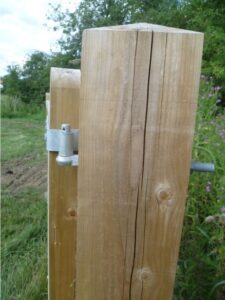
Longitudinal crack along the radius of the grain
Here’s another example, this is a crack that’s just starting to emerge, they can appear very quickly during a hot day and often after installation if exposed in the hot sun or stored in a hot environment such as a garage.
The same thing happens to furniture when out in the sun or a change of humidity.
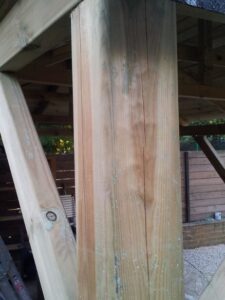
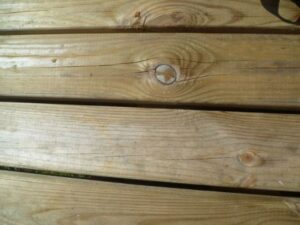
Round Poles
Round poles such as the type used in many play centres, swings and climbing frames also exhibit the same properties and often far worse:
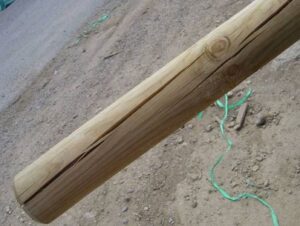
WHAT IS MAINLY AFFECTED?
The properties exhibited here are mainly found in products that utilise posts.
This is because the posts are made from a whole tree trunk. You can see that very clearly with this example. This post has been in the ground for about 12 months and supports a gate.
This post is encompassing both the ‘Heart’ and the ‘Pith’ of the tree and as such it shrinks and swells at different rates. A whole tree trunk is used as it is considerably stronger than the outside of the tree, If we were to use the outside then we would lose a huge amount of strength, the strongest part of a tree of course is the heart.
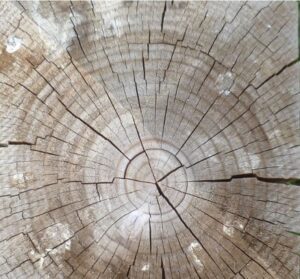
TIMBER SUMMARY
As already said, and we all know, wood is an organic substance. It also tries its hardest to match it’s environment which you may not know.
It moves, swells, and shrinks to do so and is normal timber behaviour.
This should be fully understood and expected when buying any timber product for your garden. Sometimes these cracks can open up alarmingly large but remember it is entirely normal and once the inner core has dried the crack will close up. Likewise as the moisture in the air increases so will the free water absorbed by capillary action in the wood and once again the cracks will close up.
None of these splits or cracks in the timber will affect it’s structural integrity or inherent strength.
Customers sort through the DIY shops, they buy gazebos or other ‘post’ style products and immediately reject them as being defective, this is simply not true!
Wood, by definition cannot be defective, there is nothing to go wrong other than obvious rot which is very rare in graded timber.
If you experience cracks and splits in your timber, especially when it is obviously milled from a whole trunk it is not a ‘defective’ product, nor is the strength impaired, it simply is timber exhibiting it’s normal state and characteristics.
Enjoy it and embrace it as it is part of it’s charm and warmth we all enjoy. Watch it and marvel at it’s behaviour, cracks and splits will disappear and open up.
However! Even the best treatments allow moisture transfer, even plastic does to a certain extent.
